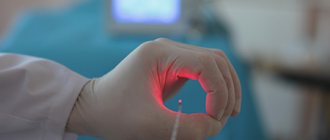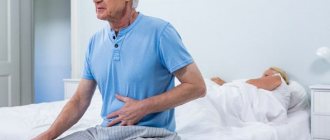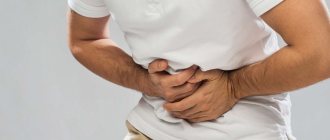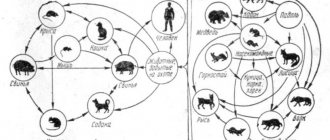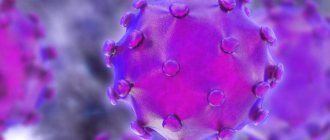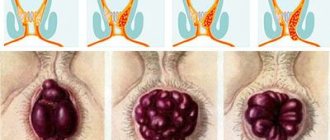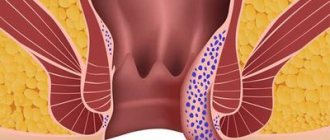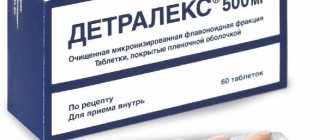Hemorrhoids are a disease of the anorectal area in which varicose veins occur in the hemorrhoidal veins of the distal rectum and/or saphenous veins located around the anus.
Hemorrhoids are a disease of the anorectal area in which varicose changes occur in the hemorrhoidal veins of the distal rectum.
Hemorrhoids mainly affect middle-aged people (45 years and older). But recently there has been a trend towards rejuvenation of diseases, including hemorrhoids. Therefore, the answer to the question of whether teenagers can have hemorrhoids is, unfortunately, positive.
How do hemorrhoids manifest at an early age and in teenagers?
Teenagers, just like adults, are embarrassed to talk about hemorrhoids. After all, at 15-17 years old it’s embarrassing to talk about such things even with your parents. For this reason, the disease is often detected in late stages.
Therefore, not only teenagers themselves, but also their mothers and fathers should know the first signs and manifestations of hemorrhoids in order to seek help from a specialist in time. Parents also need to correctly and delicately explain to the child that there is nothing shameful here.
The first sign of hemorrhoids may be discomfort in the anus or a feeling of incomplete emptying of the rectal ampulla. Sometimes your child notices blood in their stool, underwear, or toilet paper.
Pain during or after bowel movements is rarely an early manifestation of hemorrhoids.
Painful sensations appear in the later stages of the disease, when hemorrhoidal cones have already formed or complications have appeared (cracks and tears in the anus, loss or pinching of hemorrhoidal cones, etc.)
If you notice similar symptoms in your child, do not waste time and do not carry out treatment yourself; seek help from a proctologist or coloproctologist. After all, the earlier treatment for hemorrhoids is started, the more favorable the prognosis of the disease.
Symptoms of hemorrhoids in the early stages
Initially, the disease is asymptomatic. Small nodes outside the anus are not visible; they are located inside the rectum. As the hemorrhoidal veins enlarge, a person begins to experience discomfort, a feeling of wetness and periodically minor itching in the anal area. The appearance of these complaints is directly related to the release of inflammatory fluid from the intestinal tract. This inflammatory exudate irritates the skin around the anus.
Another clinical situation with hemorrhoids may also occur. The patient complains of bloody discharge from the anus, usually associated with defecation. Bloody discharge from the anus is scanty and small. The patient often does not focus his attention on them. However, many already assume that these are symptoms of hemorrhoids and try to entrust their health to a competent specialist - a proctologist.
How to treat hemorrhoids in teenagers?
The approach to treatment for patients aged 15 years is the same as for adults – comprehensive. Treatment of hemorrhoids in adolescents should consist of systemic and local drugs, physiotherapeutic procedures, physical therapy, and, if necessary, surgical intervention.
To relieve pain, adolescents are allowed to use the drug Ibuprofen.
To speed up recovery, traditional methods of combating hemorrhoids can be used in parallel with traditional treatment.
Drug therapy for hemorrhoids in adolescents:
- Systemic drugs:
- non-hormonal anti-inflammatory drugs are used to relieve pain and eliminate inflammation in the anus. Teenagers can take NSAIDs such as Ibuprofen, Voltaren, Nimid and others;
- Phlebotonics and angioprotectors strengthen the venous wall, normalize its tone, and also have an anti-inflammatory effect. Popular and effective venotonics are Troxevasin, Venoruton, Venitan, Detralex;
- laxatives are prescribed to adolescents to normalize stool. Duphalac, Picolax and others are widely used;
- hemostatic agents are used for severe bleeding from hemorrhoids. Vikasol, Dicynon and aminocaproic acid cope well with bleeding from hemorrhoidal cones.
- Preparations for local use: ointments, creams, gels, rectal suppositories. Local remedies for hemorrhoids help cope with the symptoms of the disease, reduce inflammation, eliminate constipation, stop bleeding and prevent the development of complications. The following topical medications can be used in adolescents:
- rectal suppositories: Relief, Relief Ultra, Natalsid, Procto-Glivenol, Proctosedyl and others;
- ointments, creams and gels: Troxevasin, Relief, Proctosedyl, Posterisan and others.
Relief Ultra suppositories help cope with the symptoms of the disease, reduce inflammation, and eliminate constipation.
What happens during a consultation with a proctologist?
General examination by a proctologist
The first stage of any proctological visit is a conversation, clarification of the patient’s complaints, their duration, clarification of allergy history, clarification of family cancer history. Next, an external examination of the anal area and intergluteal fold is performed. This examination allows you to detect diseases such as external hemorrhoids, anaderma, anal dermatitis, anal fissures, epithelial coccygeal ducts, often paraproctitis, viral and other skin diseases.
The next stage is a digital examination of the rectum. The doctor evaluates the presence and size of internal hemorrhoids, assesses the possibility of the presence or absence of tumors and rectal fissures. The preliminary results obtained are taken into account when performing anoscopy.
Anoscopy
Next, an anoscope is inserted into the anus.
Anoscopy is a method of examining the rectum, which allows a proctologist to examine the condition of the mucous membrane at a distance of 10-12 cm from the anus. Anoscopy is normally painless. Anoscopy is performed for the differential diagnosis of diseases such as hemorrhoids, rectal polyps, to clarify the possible source of bleeding and foci of inflammation. If there is increased pain sensitivity and the patient desires, local anesthesia can be performed using an anesthetic ointment or spray.
An anoscopic examination evaluates the condition of the rectal mucosa, its color, its structure, the presence or absence of polyps, ulcerative defects, and internal hemorrhoids. During anoscopy, therapeutic procedures are performed or may be performed. Such as photocoagulation, administration of medicinal and sclerosing substances, ligation of internal hemorrhoids is strictly individual for each patient. Medical equipment and consumables from the German concern “Storz” are used.
Surgical treatment of hemorrhoids in adolescents
The course of hemorrhoids in adolescence is mostly mild and is rarely accompanied by complications.
Also, at this age, hemorrhoids are rarely accompanied by other diseases, so surgical methods for treating this pathology are rarely used, mainly in advanced cases and with congenital anomalies of the pelvic vessels.
Preference is given to minimally invasive surgical techniques, namely sclerotherapy, ligation of hemorrhoids with latex rings, photocoagulation, etc. Hemorrhoidectomy is almost never used in adolescents.
Treatment of hemorrhoids in adolescents can be performed using sclerotherapy.
What are the reasons for the appearance of male rectal diseases?
The causes of hemorrhoids in men differ little from those listed above. Added to these are the following factors.
- Heavy physical activity when working on the railway, factory, mine, repairing heavy vehicles, where they have to intensely strain all the organs of the body. This is why pathological structural disorders, displacements of internal organs often occur, and, as a result, congestive inflammatory processes that impede the excretion of feces and the outflow of fluid. Currently, the industry produces special bandage products to protect against excessive overload of different parts of the body and increased pressure in the abdominal cavity. Preventive exercises that train blood vessels and muscles will also help.
- Most men love smoked sausages, fish products, marinades seasoned with spicy additives, and drink large quantities of beer. All unhealthy food causes degeneration of cells of the digestive organs, disturbances in the metabolism of carbohydrates, proteins, fats, and water-salt balance. This is also the cause of exacerbation of hemorrhoids. To get rid of dysbiosis that occurs from overeating junk food, which contributes to very frequent or too infrequent bowel movements, you need to completely abandon bad gastronomic habits. Living without delicacies will be boring for some time, but proper nutrition will protect you from half-an-hour agony and pain during bowel movements. As a result, from terrible lesions of the rectum.
- Another reason for the development of hemorrhoids in men is prolonged sitting while working. It is mainly present in truck drivers, machinists, truck crane operators, bulldozer operators, junior managers and white-collar clerks. We must remember that a prerequisite for good physical condition is periodic getting up, walking, and exercising a specific muscle group.
Some managers don’t care at all what your health is, take care of yourself, don’t pay attention to the sidelong glances of your greedy boss.
Treatment of hemorrhoids in adolescents with folk remedies
Teenagers can use warm or cold baths on the anus with decoctions of medicinal herbs, for example, oak bark, yarrow, mullein, onion peel, calendula, chamomile.
Cold has an excellent antihemorrhoidal effect. Lotions and compresses with cold water or cold decoctions of medicinal herbs will help cope with pain, itching and burning in the anus, and reduce the size of hemorrhoids.
To normalize stool, it is recommended to drink 15-20 ml of olive oil daily on an empty stomach.
There are many different methods of alternative treatment for hemorrhoids, but the use of any of them must be approved by the attending physician.
Your hemorrhoids will be cured:
Bondar Alexander Stepanovich Highest qualification category.
Specialty: Surgeon, proctologist, proctologist-surgeon, head of the proctology department of the Minsk Regional Clinical Hospital (MRCH).
Direction: Proctology
Work experience: More than 20 years.
What diseases does it treat: proctological diseases of any complexity. Individualized diagnosis and treatment of all nosological forms in an outpatient medical setting.
Rubtsov Vladimir Aleksandrovich Highest qualification category in the specialty of surgeon, first in healthcare organization.
Specialty: surgeon, proctologist surgeon, proctologist of the Department of Proctology of Purulent Surgery (HO No. 2)
Direction: proctology, surgery.
Work experience: more than 35 years.
What diseases does it treat: proctological diseases of any complexity. Individualized diagnosis and treatment of hemorrhoids in an outpatient medical setting.
Performing a cleansing enema before consulting a proctologist
Buy an Esmarch mug, perform one enema in the evening and one in the morning 4 hours before the visit, if the consultation with the proctologist is scheduled in the morning. If the consultation is scheduled in the afternoon (17-19 hours), perform an enema in the morning and another cleansing enema 3-4 hours before the examination. After performing the enema, at least 3 hours, and preferably 4 hours, should pass until the consultation with a proctologist in the cities of Minsk, Zhodino, Borisov.
Preparing for a visit to the proctologist using a laxative
Preparing for a consultation with a proctologist using a laxative is an alternative way to cleanse the intestines. Currently, one of the most popular and registered in the Republic of Belarus is the drug Fortrans. This method is used with caution by those patients who have a history of surgery on the abdominal organs and intestines.
Nutrition for hemorrhoids in adolescents
For hemorrhoid treatment to be effective, it must be combined with diet. The main purpose of nutrition for hemorrhoids is to improve the functioning of the digestive tract and eliminate constipation or diarrhea.
The daily diet of a teenager with hemorrhoids should consist of vegetables (zucchini, pumpkin, potatoes, beets, carrots and others).
Nutrition for hemorrhoids should be complete and balanced. It is better to eat fractionally - 5-6 times a day in small portions.
The daily diet of a teenager with hemorrhoids should consist of fermented milk products, vegetables (zucchini, pumpkin, potatoes, beets, carrots and others), fruits, cereals, lean meats, poultry and fish.
If you have hemorrhoids, it is not recommended to eat white cabbage, rye bread, spices, legumes, cocoa, strong tea, coffee, rice, jelly, sorrel. Drinking alcoholic beverages is strictly prohibited.
You should also not forget about sufficient drinking regimen - 35-40 ml of liquid should be per 1 kg of body weight, not counting liquid food. You can drink water, teas, fruit drinks, juices, compotes, still mineral waters.
Minimally invasive / low-traumatic technologies in the treatment of hemorrhoidal disease
Hemorrhoids (from ancient Greek αἷµα - “blood” and ῥοῦς (< ῥόος) - “flow”) is a disease associated with thrombosis, inflammation, pathological expansion and tortuosity of hemorrhoidal veins that form nodes around the rectum. According to statistics, about 15% of the entire world population suffers from hemorrhoids. The prevalence of the disease is 140-160 people per 1000 adults, and its share in the structure of colon diseases ranges from 34 to 41%. An impressive figure, isn't it? And only about half of these “lucky” ones go to the doctor in the early stages of the development of the pathology. The rest are saving their time, hoping for “maybe”, or do not want to notice the annoying symptoms of the disease at all. In vain.
According to statistics, about 15% of the entire world population suffers from hemorrhoids
Causes of hemorrhoids
- gastrointestinal disorders
- errors in diet
- alcohol abuse
- sedentary and sedentary lifestyle
- pregnancy and childbirth
Hemorrhoids: symptoms and signs
Prolapse of internal hemorrhoids from the anus during defecation, discharge of blood from the anus during defecation (admixture of scarlet blood in the stool, discharge of blood in the form of drops or streams) Rarer symptoms include (or occur more often in later stages):
- feeling of discomfort
- feeling of incomplete bowel movement
- moisture in the anus
- itching, burning in the anus
- mucous discharge from the rectum
Remember! The main symptoms of acute hemorrhoids include: pain in the anus and rectum
- the appearance of a dense, painful formation(s) in the area of external and/or internal hemorrhoids
- profuse copious discharge of blood from the rectum, which does not stop with the help of conservative measures
Stages of the disease
Stage 1 – Discomfort and bleeding during bowel movements, no prolapse of nodes.
Stage 2 – stage 1 + periodic loss of nodes. The nodes recede on their own, mucous discharge, weeping and itching appear.
Stage 3 – stage 2 + but manual reduction of nodes is required
Stage 4 – Stage 3 insufficiency of the anal sphincter, severe weeping and itching, constant prolapse of the nodes, reduction is not possible.
How is hemorrhoids treated at the Grand Medica clinic?
To diagnose hemorrhoids at the initial consultation, the coloproctologist performs a visual examination, digital examination, anoscopy and, if indicated, sigmoidoscopy (painless instrumental examinations).
Most patients with stage 1–3 internal hemorrhoids, if conservative therapy is ineffective or insufficiently effective, are advised to perform minimally invasive surgical treatment methods:
- sclerotherapy
- infrared photocoagulation
- ligation of hemorrhoids with latex rings
- disarterization of hemorrhoids under ultrasound Doppler control and disarterization of hemorrhoids with mucopexy (according to the HAL-RAR method)
- traditional hemorrhoidectomy
Sclerotherapy
The method involves solving the problem of hemorrhoids by blocking the access of oxygen to the hemorrhoids. The essence of the procedure is the introduction of a special substance - sclerosant - into the space of the node, which subsequently leads to the appearance of an inflammatory process in the vein. As a result, the shell of the vessel sticks together and becomes overgrown. After the blood supply stops, the node dies
Advantages of the procedure:
- Ease of manipulation. Painless.
- During sclerosis, the patient can only feel a slight burning sensation and tingling. efficiency of the manipulation.
- Ambulatory treatment.
- It is possible to treat hemorrhoids even in older people if other methods are contraindicated for them.
- Quick results.
Infrared coagulation
An infrared coagulator acts on the pedicle of the hemorrhoid with an infrared heat wave, “sealing” the vessels. As a rule, it is prescribed for stages 1-2 of the disease, and also gives excellent results with complex treatment in combination with other methods.
Latex ligation
Latex ligation is the most common method of treating hemorrhoids without surgery. Latex ligation is one of the most popular methods of treating hemorrhoids and has a number of advantages over surgical treatment methods:
- does not require a long recovery period
- carried out quickly and painlessly
- in most cases avoids surgery
How is the latex ligation procedure performed?
The essence of the procedure is quite simple. Special latex rings are placed at the base of the internal hemorrhoids. No anesthesia is required. The procedure is quick and painless.
As a result, blood circulation in the tissues of the node is disrupted, and therefore the tissues begin to die. As a rule, the process begins 2-3 days after the procedure. As a result, after a few days the hemorrhoid dies and is rejected. In its place, a kind of stump is formed, covered with connective tissue. Ligation with latex rings is effective for stages 1-2 of the disease.
HAL-RAR technology
HAL execution principle
- The doctor ties each artery, reducing the flow of arterial blood to the enlarged hemorrhoid. Sutures are placed in the intestinal lumen, where there are no pain receptors. The procedure is performed painlessly.
- Next, the tissue of the internal hemorrhoid is compressed using a running stitch. Continuous lifting suture - RAR which returns to the normal position as before the disease. In this way we restore the normal functioning of the rectum.
Advantages of HAL-RAR
- No wounds or severe pain in the postoperative period.
- Only 1 day of hospital stay.
- Return to work in 1-2 days
- Very high efficiency of the method all over the world.
Traditional surgical treatment
The Milligan-Morgan operation, proposed back in 1937, still remains popular among coloproctologists in our country.
Although in most countries of America and Europe a typical hemorrhoidectomy is performed in only 17-21% of patients, the rest use minimally invasive treatment methods. Currently it is divided into two types.
Closed hemorrhoidectomy – with restoration of the mucous membrane of the anal canal. It is indicated for stage 3-4 hemorrhoids in the absence of clear boundaries between the external and internal hemorrhoids.
Open hemorrhoidectomy – involves removing the external and internal nodes en bloc, leaving an open wound of the anal canal. This operation is indicated for stage 3-4 hemorrhoids with a combination of anal fissure or paraproctitis.
A list of physical therapy exercises that are indicated for patients with sphincter insufficiency.
The starting position of the patient is on his back.
Select 4-5 exercises from the list, repeat each 7-10 times 2-3 times a day.
- Hands on the lower back: contracting the gluteal muscles, forcefully pull in the anus and hold for 15-20 seconds.
- The legs are bent at the knee joints and the feet are connected. Spread and bring your knees together.
- Legs are bent, feet near the buttocks. Raise your pelvis up, leaning on your feet and shoulder girdle. At the same time, strongly strain the gluteal muscles, pulling the anus into yourself.
- Legs bent, feet near buttocks. Raise your pelvis up, leaning on your feet and shoulder girdle. At the same time, lift the straightened leg up and move it to the side.
- Extend your arms along your body, legs straight. Raise your pelvis, resting on your heels, elbows, shoulder girdle and head, retracting your anus. Returning to the starting position, relax the gluteal muscles.
- Hands under your head. Raise both straight legs up, spread to the sides, bend at the knee joints, straighten, bring together and return to the starting position.
Diet No. 3 according to M. I. Pevzner
Cooking technology: food is prepared mainly unchopped, boiled in water or steamed, baked. Vegetables and fruits are consumed both raw and boiled. Food should mainly consist of vegetables, fresh and dried fruits, baked goods, cereals, and fermented milk drinks.
Allowed:
- Bread – wheat bread made from wholemeal flour: “Doctorsky”, “Zdorovye”, crispbread (soaked), rye. The cookies are dry, unpalatable pastries.
- Soups - mainly from vegetables in meat broth, cold fruit and vegetable soups, borscht, beetroot soup, cabbage soup made from fresh cabbage.
- Meat and poultry – lean varieties of various types of meat, chicken, turkey, boiled or baked, in pieces or chopped. Milk sausages.
- Fish – low-fat types, boiled or baked; seafood dishes.
- Vegetable dishes and side dishes - various types of vegetables and herbs, non-acidic sauerkraut, beets are especially recommended. Dishes and side dishes made from flour, cereals, legumes, crumbly and semi-viscous porridges, puddings, casseroles. Pasta, boiled and in the form of casseroles, dishes made with buckwheat are especially recommended. Legumes: green peas, bean curd.
- Eggs – no more than one egg per day, it is better to add them to dishes.
- Fruits, berries, sweet dishes and sugary products - melons, plums, figs, apricots, prunes, sugar, jam, especially rowan, honey, compotes (especially rhubarb), mousses, fruit candies are especially recommended.
- Milk, dairy products and dishes made from them - milk (if tolerated - sweet), sour cream, cottage cheese, yogurt, one- and two-day kefir, acidophilus milk, cheeses.
- Sauces and spices - milk, sour cream with vegetable broth, fruit and berry sauces.
- Fats – butter, vegetable oils from dishes.
- Appetizers - raw vegetable salads, vinaigrettes with vegetable oil, vegetable caviar, fruit salads, mild cheese, low-fat ham, soaked herring, jellied meat and fish.
- Drinks - tea, coffee substitutes, rosehip and wheat bran decoction, fruit and vegetable juices (plums, apricots, carrots, tomatoes).
Prohibited:
Bread made from premium flour, puff pastry and pastry, fatty meats and fish, duck, goose, smoked meat and fish, canned fish and meat, (limit rice and semolina), radish, radish, garlic, onion, turnip, mushrooms, jelly, blueberries, quince, dogwood, chocolate products with cream, hot and fatty sauces, horseradish, mustard, pepper, cocoa, black coffee, strong tea, animal and cooking fats, alcoholic beverages.
The clinic's coloproctology service has the most modern equipment and technologies for diagnosing and treating a wide range of diseases of the colon and rectum.
Make an appointment with a proctologist by phone or leave a request on the website.
Prevention of hemorrhoids in adolescents
It is necessary to engage in the prevention of hemorrhoids from early childhood. You can prevent hemorrhoids in your child using the following recommendations:
- introduce complementary foods to your child on time and correctly;
- The child’s diet should be balanced and varied with sufficient fiber content (beets, carrots, cabbage, legumes);
- Do not give your child fried, fatty or spicy foods. Give preference to steamed or oven-baked dishes;
- limit rice, meat, baked goods, sweets, and strong black tea in your child’s daily diet;
- replace sweets with dried fruits, which, moreover, are an excellent prevention of constipation;
- keep the child sufficiently hydrated;
- Introduce your child to sports from childhood.
[morkovin_vg video=”3XlN3JmuJ9I;z0FdxrRQkig”]
If you suspect your child has hemorrhoids, take him to a proctologist to start the fight against this unpleasant disease in time. Only strict adherence to the recommendations of your doctor and maintaining a healthy and active lifestyle will help cure juvenile hemorrhoids.
Factors that can provoke hemorrhoids
Crying
During the newborn period, a baby may cry very often. In this case, crying is accompanied by an increase in intra-abdominal pressure and venous stagnation in the pelvis. The result may be the appearance of hemorrhoids. Therefore, if a child is restless and cries frequently, you should consult a doctor to find out the cause and treat the problems that provoke the child's anxiety.
Sitting on the potty Prolonged stay of the child on the potty causes venous stagnation in the rectal vascular system. Therefore, preventing constipation in children is also preventing hemorrhoids.
Unbalanced diet This factor is more important for older children. Schoolchildren are at risk for this disease precisely because of dietary disorders: irregular meals, eating chips, fast food and large amounts of quickly digestible carbohydrates as snacks disrupts the rhythm of bowel movements and can provoke constipation.
Lifestyle Modern schoolchildren prefer entertainment on the computer or in front of the TV to active games in the fresh air. Prolonged sitting causes poor circulation in the pelvis and can also cause hemorrhoids.
Congenital characteristics There is a hereditary predisposition to hemorrhoids. The structural features of the venous wall of the rectal vessels, with the additional influence of other factors, can provoke the development of hemorrhoids.

